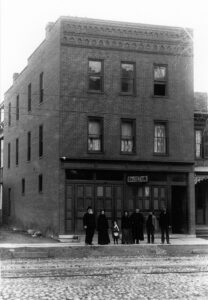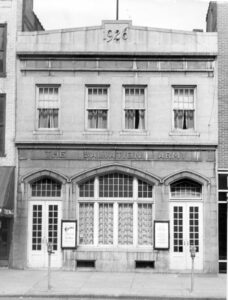Salvation Army
By Becky Chapin, Archivist
This year marks the 135th anniversary of the Salvation Army’s presence in Geneva. The origins of the Salvation Army in Geneva are incredibly interesting for someone like me who was a religious studies minor in college (granted that meant taking classes like Religion and Sci-Fi which was definitely no hardship), but research also reveals prejudices held by Genevans.
Born out of revival meetings in England, the Salvation Army’s roots began with William Booth in 1865 during a series of evangelistic meetings in the East End of London. His first parishioners were desperately poor and were not welcome in most churches; Booth wanted to provide practical help to the poor and destitute while also preaching the Gospel to them. Originally known as The Christian Mission, they described themselves as a “volunteer army” which was soon replaced with the name “salvation army.” Despite violence and persecution, between 1881 and 1885 some 250,000 people were converted under the ministry of the Salvationists. The Salvation Army gained a foothold in the United States in 1879 in Philadelphia through Lieutenant Eliza Shirley and by the mid-1880s pockets of salvationists were appearing in upstate New York.
Appearances in other villages and cities in the Geneva area did not inspire goodwill among residents. Other cities reported arrests of Salvation Army workers for disturbing the peace in Syracuse, Rochester, Waterloo, and Seneca Falls. Reprinted articles from other villages claimed that the salvationists were laying siege to their village (Phelps) and that their influence over immature young people was dangerous (Seneca Falls). Reports of visits of salvationists to Geneva appeared in newspapers in 1885, but citizens were far from welcoming.

Salvation Army headquarters (387 Exchanged Street) in 1897
By April 1885, the Geneva Advertiser expressed discontent about the “Salvation Army gangs that have visited every other week for the past four months” and “have generally met with reverses. They have found Geneva is in no need of their services. It is a very easy matter to rid a town of them – refuse to contribute to their support.” They also claimed in May 1885 that “Geneva has church room enough for all people in the village. Six thousand can be seated in all our churches and places of public worship…” questioning, “What therefore is the need of the Salvation Army.”
What’s interesting in the newspapers is that there are all sorts of different views taken about the salvationists. While the Geneva Advertiser expresses doubt and scorn about the salvationists’ work, the writers of the Geneva Daily Gazette said that Genevans would never show disrespect to any religious organization. Even so, the Geneva Daily Gazette reported in June 1885 that the army made arrangements for holding a campaign in Geneva, leasing the old Scotch Church, but reporters visited the first meeting and were “very unfavorably impressed. One evening of that sort of salvation business is enough.”
The newspapers claimed not a single person had been taken into their camp by June, “not because Genevans are constitutionally bad, but…there are churches and ministers enough for all purposes; and seats in the churches are denied no one.” But oddly enough, there had been some support. The same article describes a George Stroup who said he had been told the army was “no good; that all they wanted was money, money” but that he had “great confidence” in them and would like to see them warmly supported; he said “If I were rich, I would give to this salvation army one thousand dollars tonight.”
The salvationists had been using the Old Scotch Church until December when they were notified to vacate the building, though they “did not go quietly” and danced through the streets. Their style of marching through the streets making music was not favored by residents. By February 1886, the Geneva Advertiser claimed the group was on its last legs, that they had heard nothing more of them in Geneva; indeed reports circulated that the group was leaving many cities in the area. But they rebounded in May with a banquet and jubilee, parading through the streets “which drew quite a liberal patronage” made of nearly sixty people from nearby towns. Another parade in June was described as “a hapless quartette of harmless fanatics.”

Food collection and distribution, 1950s
For the first few years in Geneva, the army bounced around many places, using rooms above businesses as worship places, finding enough rent money to use the rooms at the old Scotch Church again. Perhaps it was that the movement was spearheaded by a few unnamed women – who “made such a show of themselves” including “The Captain” who was “a woman, with arms and muscle big enough to insure order if words fail her. From her style of speech it is evident that she was not educated in a college” – but in 1886, with four men in charge, the newspapers were more willing to listen to their message. Despite this, a year later the group was described as “loud mouthed, coarse, unattractive, some of them with questionable records, posing before the public as reformed gamblers and reformed drunkards.”
Sometimes we have to take articles with a grain of salt. These papers were published by well-off, white men in Geneva, did they have the full picture of the salvationists? Did they even have a full picture of Geneva itself? George Stroup is listed as a bill poster in several directories…how much do you think that job paid? Did George benefit from the work the salvationists were doing? Newspapers from this time don’t give the full picture of a subject because it didn’t tell us the perspective of those the Salvation Army were originally intending to help.
Against all odds, the Salvation Army gained enough members and support to continue on, helped by the other salvationists in nearby cities who had garnered support early on. The group would move into their own building at 387 Exchange St (formerly Nester Hose Fire Co.) in 1897 and were able to offer Christmas dinner to families and others who would otherwise be unable to celebrate, supported by donations from Genevans. Indeed, by 1900, the national Salvation Army was commended by the Geneva Daily Gazette for their shelters, rescue homes, children’s homes, and kindred social institutions. The editors recommended that Genevans help with the Salvation Army Relief Fund and lauded the group for their work with the poor, calling them “friend and comforter of the poorest and lowliest.”
Barracks were listed at 431 Exchange (Nester Block) in 1899 and they would move into the corner building opposite in October 1904 (442 Exchange). Compared to 1885, a profound change in tune for Genevans can be found in 1925, when a building campaign began. The Geneva Daily Times said that by supporting the Salvation Army, “Genevans affirm and renew their faith in humanity and the power of human sympathy to elevate to self-respect, industry and useful citizenship…”

484 Exchange Street
The annual report for 1925 said there were approximately 364 meetings held, nearly 800 ‘transients’ supplied with free beds, employment secured for about 100 men, more than 1,000 hours spent visiting the sick and 4,000 garments, shoes, etc, were distributed to those in need. It’s clear that the Salvation Army provided support for Geneva’s most vulnerable and that Genevans had returned that support. The building campaign would raise the funds needed for the organization to build a new place that would house the barracks and main audience hall at 424 Exchange Street just a few doors down (present day Baroody’s Cigar Store).
The Salvation Army would remain in 424 Exchange Street until 1974 when the size of the building could no longer keep up with their activities and large functions. Outside groups met regularly there – Cub and Boy Scouts, Girl Guards, Corps Cadets, Bible groups, young people’s legions, Home League for women, Men’s Club – not including the Army’s own worship services, youth and adult programs, and social, religious, and charitable programs.
The building itself was deteriorating, increasing the need for better facilities. Enough funds were raised by the community that the Salvation Army was able to build another location at 41 North Street where they have remained since 1974.

A captain Booth was at the Geneva. NY one in earlier years I believe